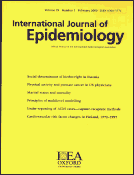In this month’s edition of the International Journal of Epidemiology (IJE), edited in the Department of Social Medicine at Bristol University:
- Health effects of divorce and widowhood
- Protective equipment 'ineffective' in preventing rugby injuries
Health effects of divorce and widowhood
Divorce and widowhood have both health-damaging and health-promoting effects among middle-aged and elderly women, according to new research from Harvard University.
Dr Sunmin Lee and colleagues used data from the Nurses’ Health Study, an ongoing cohort of female registered nurses in the US. They examined data from 80,944 women who had provided details of their marital status in 1992 and 1996, and compared the health behaviour of women who had remained married with those who had been divorced or widowed.
While previous studies have indicated that married people have lower mortality and are generally healthier, few have examined the effect of marital transition on health.
The researchers found that divorced or widowed women were more likely to smoke than married women and that married women were more likely to consume fruits and vegetables and were more likely to have had a mammogram in the past two years.
They also found that marital disruption was strongly associated with weight loss: women who were divorced or widowed had body mass index (BMI) decreases, compared with women who remained married However, the trend seemed rather short-lived with women who remarried experiencing an increase in their body mass index.
Divorced women were also more likely to be physically active than women who stayed married.
Dr Lee said: “Our data indicate that divorce and widowhood among middle-aged and elderly women are both health-damaging (smoking relapse, increased drinking and poorer diet) and health-promoting (increase in exercise). Conversely, remarriage is associated with generally health-promoting behaviours.
“The effects of marital transition on women’s health were not as dramatic as those previously reported in men. The benefits of marriage are known to affect men and women differently: the marital role of women is more likely to be characterised by care-giving, which is more likely to be beneficial to their spouses’ health.”
Paper: S Lee, E Cho, F Grodstein, I Kamachi, F B Hu and G A Colditz: ‘Effects of marital transitions on changes in dietary and other health behaviours in US women’.
CJD epidemic 'unlikely'A new French study confirms that a large vCJD epidemic in France is very unlikely. Since France (where 60% of the total British exports of bovine carcasses were exported) has been highly exposed to the BSE agent, these results are reassuring for most countries worldwide.
France has the second highest incidence of vCJD worldwide. The number of vCJD cases are, however, much lower in France than in the UK (8 and 151, respectively).
The study by Dr Marc Chadeau-Hyam and Dr Annick Alpérovitch of the Hôpital La Salpêtrière, Paris aimed to forecast the number of vCJD cases in France based on exposure to BSE through British infected meat imported to France or consumed by French travellers visiting the UK. As an age-dependent risk of vCJD has been observed (two-thirds of vCJD cases are aged between 15 and 35 years), exposure linked to the consumption of infected beef was computed by birth-cohorts (pre-1940, 1940-69, post 1969).
The researchers found that a total of 33 vCJD cases are expected in France: 12 cases in the 1940-69 cohort and 21 in the post-1969 cohort. Only three cases are expected to occur after 2020. No case was predicted in the pre-1940 cohort.Paper: M Chadeau-Hyam and A Alpérovitch: ‘Risk of variant Creutzfeldt-Jakob disease in France’.
Protective equipment 'ineffective' in preventing rugby injuries
The protective equipment used in rugby union has limited effectiveness in preventing injuries, according to a study by researchers in the US and New Zealand.
A cohort of 304 rugby players in Dunedin, New Zealand was followed weekly during the 1993 club season to assess protective equipment use, participation in rugby and injury outcomes.
While the use of mouthguards appeared to lower the risk of orofacial injury and padded headgear tended to prevent damage to the scalp and ears, the risk of concussion was not lessened by the use of padded headgear or mouthguards. Nor was any evidence of protective effects found for any other equipment (taping, shinguards and grease).
Dr Stephen Marshall of the University of North Carolina at Chapel Hill, lead author of the study said: “Previous research indicates that there is significant potential for protective equipment as an intervention to prevent injury in contact sports. However, our findings suggest that, beyond support sleeves, mouthguards, and headgear, the protective equipment used in rugby appears to be largely ineffective in preventing injury. Of particular concern is the finding that mouthguards and padded headgear appear to offer very little, if any, potential for the amelioration of the risk of concussion in rugby.”
Paper: S W Marshall, D P Loomis, A E Waller, D J Chalmers, Y N Bird, K L Qarrie and M Fehan: ‘Evaluation of protective equipment for prevention of injuries in rugby union’.
The International Journal of Epidemiology
The International Journal of Epidemiology is a key journal in the field of epidemiology and public health, published six times per year by Oxford University Press. It is edited at the Department of Social Medicine, University of Bristol, which is a leading centre for epidemiology, health services research and public health in the UK and was one of only three to be awarded the top 5* grade in the 2001 Research Assessment Exercise.
